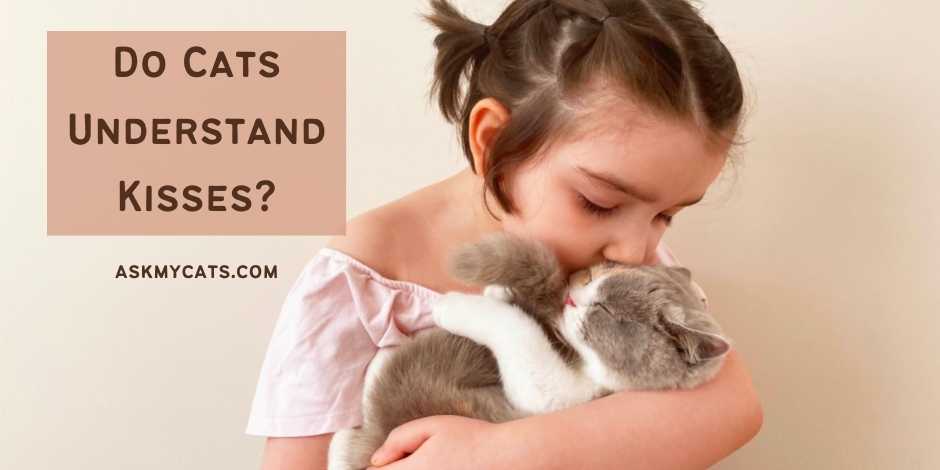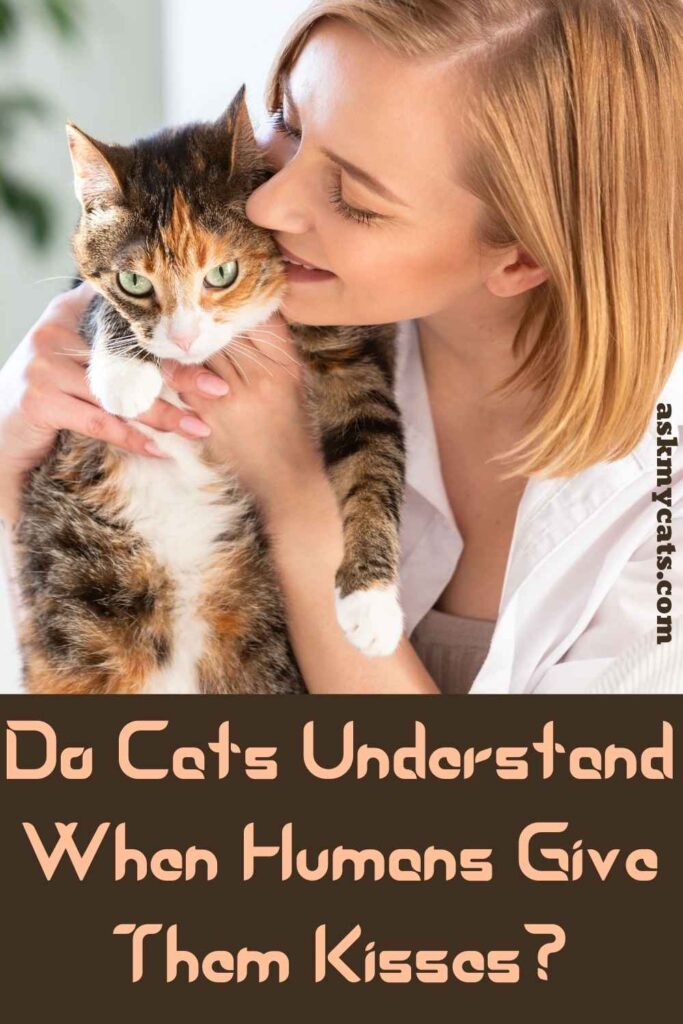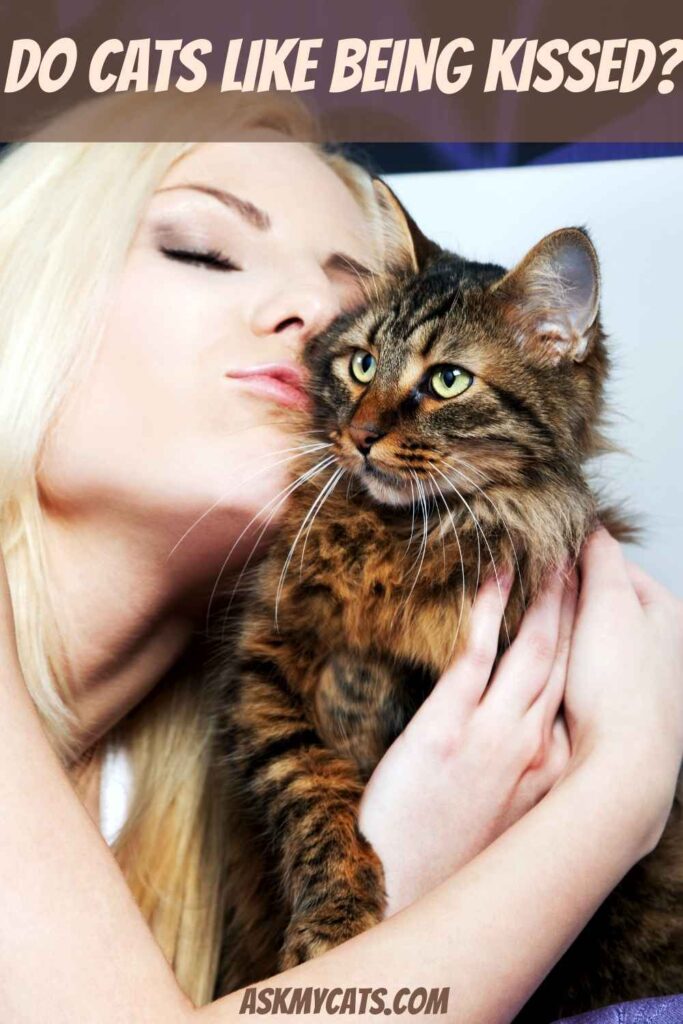Despite their aloof, independent, and disconnected public image, felines are frequently incredibly friendly, loving, and cuddly creatures, as any die-hard cat lover will excitedly tell you.
Although cats may not “kiss” you in the same way that humans do, they do have their own loving gestures — aww.
Cats display affection in a similar way; therefore they’re presumably aware that kissing is a type of affection.
They may rub their nose on another animal to indicate affection. They also groom other animals to express affection.


Give Your Cat the Perfect Day
Get the Free Ebook!
Do Cats Understand When Humans Give Them Kisses?
Cats do the same thing when they rub up against us to deposit their smell on us, so I’m guessing they’ll interpret that as us depositing our smell on them.

If you kiss a cat while quietly saying things like “excellent kitty” or “we’re so happy to have you” and patting them, I believe they’ll just lump the kiss in with the other positives and realise that getting a kiss is a good thing.
If you try to kiss your cat and receive a negative or no response, it’s possible that your cat doesn’t feel near enough for that type of affection.
For cats, bringing their heads close together is a profoundly intimate experience. It is the highest form of affection for cats to bump heads.
For that type of attachment, they must be very comfortable and trusting of you.
If you and your cat have a solid connection, the cat may recognise that you are offering him attention and tolerate the connection, even if it isn’t his preferred method of receiving attention.
Cats kissing at a distance are a more informal manner of doing so. To indicate trust and devotion, they make eye contact and then gently blink.
You should gently blink back to react. Those trust blinks are probably your cat’s equivalent of kisses. Head bumps and genuine kissing necessitate a higher level of trust.
What they sense/get, I believe, is the aura, if you will, of our tremendous affection for them. They can detect the aura of a non-cat lover, just as they can detect the aura of someone who loves them.
It’s similar to when you run into a kind, smiling individual.
In contrast to the gloomy, scowling individual you encounter, most individuals will reply in kind. Cats are capable of experiencing and expressing affection.
They are also quite observant and rarely miss anything. My cat is highly devoted to me and is highly linked to me.
He can see my sorrowful expression and reply by seeming frightened, then rush up to me and remain with me. I’m sure he thinks he’s looking after me.
When I’m unhappy, he only reacts in this way. He also licks me and cuddles me with his paws, luring me closer to him.
His “kisses” are little nips with his front teeth…which don’t feel nice because I don’t have a hide, but I put up with them just like he puts up with my loads of kisses all over him.
I’m sure he’s trying to show me how much he cares…and I’m sure he’s aware that I’m doing the same.
Must Read: Is It Safe to Kiss Your Cat on the Nose?
Do Cats Like Being Kissed?
Human kisses seem to be liked or tolerated by certain cats. When you kiss your cat, he probably knows that you’re attempting to show him affection by leaning in, purring, and rubbing his head on you.
Your cat does not want to be kissed if his ears fall back, he begins to whip his tail back and forth, moves away from you, hisses, or swats at you.
Kissing in the human sense isn’t how your cat will show you he loves you, and it’s probably not the best way for you to show him you love him.
Cats utilise body language to express their love for their people. Cats’ slow eye blink is a powerful method of saying “I love you.” This is similar to a human kiss; however it’s done from across the room rather than with physical touch.
Another way cats express affection is via head-bumping.
A feline head bump shows affection, even though it may knock your glasses off, give you a sore nose, or threaten to knock you off your feet depending on where the bump is administered on your body.
Cats brush against you to express their affection. Because they have smell glands on their cheeks and lips, rubbing on you is a means for them to identify you as their own.

1. Kisses From You
If you kiss a cat, she will most certainly enjoy the gesture and feel appreciated, even if she doesn’t grasp the standard definition of the action.
With cats, human contact goes a long way. Although there are always grumpy exceptions, cats generally like attention and contact.
If you offer a willing cat positive attention, whether it’s kissing her head, scratching her tummy, or even softly caressing her back while watching TV on the couch, she’ll probably eat it up.
2. Subtle Blinking
A feline may “kiss” you by gently but steadily blinking at you, which is an unexpected — yet completely sweet — manner of doing so.
When she does this, she is expressing her love for you, but there is an added benefit. The action demonstrates a high level of trust.
After all, if your cutie closes her eyes around you even for a millisecond, it means she’s certain you won’t do anything to hurt her.
3. Tail High Up
Observing the tail is a fantastic way to figure out what a cat is feeling. There are exceptions to the rule that a moving tail is not a love gesture.
When your fluff ball’s tail strays upwards and faintly shakes, it suggests she’s overjoyed to see you.
Despite the fact that this isn’t a tangible activity, it is a true analogy to a kitten kiss, so rejoice.
4. Ears Up
Looking at her ears might also provide another indicator of cat fondness.
If her ears are perked up, it means you have her undivided attention — and she’s ready for some love and attention from you, whether it’s kisses, embraces, or plain old-fashioned petting.
5. Head-butting
Head-butting is one of the most common ways for a feline to “kiss” a person. Your cat may be expressing something to you if she rubs her cheeks and chin on you “Hello there. I adore you.”
Cats, on the other hand, may be perplexing creatures. Rubbing isn’t always a sign of affection. If your cat rubs her entire body across your legs, for example, she isn’t necessarily being a kind little thing.
She might just be marking you with her smell and warning all other cats in the area to stay away because you are hers and hers alone. Oh, no!
Is It OK To Kiss Your Cat?
Yes, you can kiss your cat but make sure that both of you are healthy and not carrying any germs or diseases.
The first thing you should think about is if you and your pet are both healthy, as illnesses may be transmitted through kissing. If one of you is sick, this form of intimate contact should be avoided at all costs!
Another thing to consider is if your cat is accustomed to this amount of human contact. If you’ve never kissed somebody before, they may not like the unexpected invasion of their personal space.
The most essential thing to remember while kissing is to avoid kissing on the lips for hygienic reasons.
It’s also preferable to avoid touching the stomach, as most cats dislike having their stomachs rubbed. Cats love short encounters, so if you want a kiss, a little peck would suffice.
Do Cats Like Hugs?
Yes, of course! Many cats, especially some kinds, quite love and like lying on laps, nuzzling into necks, and, yes, hugging.
Burmese, Ragdoll, and LA Perm cats, for example, are noted for building deep ties with their two-legged relatives.
For starters, they don’t flee in the opposite way when they notice you approaching!
When you embrace your cat, he may tighten up, try to flee, or make low, throaty vocalisations to let you know he’d prefer be left alone.
If he lets you hold him easily and purrs loudly, on the other hand, he’s undoubtedly grateful for the embrace.
Is It OK To Hug Your Cat?
Yes, it is absolutely ok to hug your cats because this is the way to show your affection towards your pet.

First and foremost, do not surprise or sneak up on your cat.
If you startle or disrupt him when he’s resting or eating, you’re likely to get a scratch rather than some snuggling time.
Begin by lightly touching your cat to discover if he’s interested in a hug. Then be kind with yourself. Some cats have a rough exterior, yet they just need to be handled with caution.
Don’t grip him too firmly or forcefully, and let off if he appears to be uncomfortable. Allow him to come to you as well. Some cats would rather be petted on their own terms. Sit or lie down near your cat and see if he would approach you for a cuddle.
This may be the best option for cats that don’t enjoy being lifted up but still want to be petted.
Positive reinforcement in the form of gentle praise delivered in a soothing voice can help your cat learn that hugs are a good thing. Last but not least, know when to let go.
Allow your cat to wiggle or draw away if he starts to wiggle or pull away after a brief embrace. Later, when he’s calmer, try again.
If you want to hug your cat and ensure that he or she does not become stressed as a result of the encounter, you need do it properly, which involves embracing cats on their own terms.
You should never, ever sneak up on or swoop in on your cat since this will stress and terrify them. Allow your cat to approach you and take a seat in your lap.
Talk to your cat and softly stroke her in her preferred location—under the chin is a good choice. Put your arms freely around your cat if she is relaxed and cheerful (purring is a plus!).
You’ll be OK if your cat remains quiet and content. Don’t hold your cat too firmly, and if she shows indications of stress or tries to flee, let her go.
Hugging my cat is one of his favourite things to do!” As I previously stated, there are exceptions to the norm, but I can’t justify devoting a whole day to a technique that stresses out nine out of ten cats.
“National Do Something Nice for Your Cat Day” is a better name.
Instead of embracing cats (which they despise), we should give them more vertical space, give them cat treats, get a new cat tree or some puzzle toys that you can fill with cat food, or take them to the vet for a check-up to have any potential (and unpleasant) dental illness fixed.
Those are certainly better ways to appreciate your cat.
Frequently Asked Questions
Is it bad to kiss your cat on the nose?
Kissing kitten on the lips or the tip of the nose is not a good idea because you know where the nose and mouth have been. Also, don’t kiss feline or canine while they’re fast asleep. This may cause the pet to get startled.
Can you get toxoplasmosis from kissing your cat?
Because the bacterium is not distributed by the fur or saliva, it is exceedingly improbable that you would contract toxoplasmosis by caressing or being scratched or bitten by your cat. Toxoplasmosis can be contracted by eating undercooked contaminated meat, particularly lamb and pork.
Is it bad to kiss your cat on the lips?
A cat’s mouth may thus be no dirtier than our mouth at any one time. However, in their mouths, cats have several additional germs causing gum disease. To be safe, keep your cat from kissing the lips. A peck on the head has a lot less possibility of illness and is just as affectionate.
Final Words
You would be right to ask if, when you are in the habit of kissing your cat, they would enjoy your lips on their faces or furs or genuinely wish you would simply stop there.
Nevertheless, it is crucial to find out which group your kitten comes into, as unpleasant kisses for a feline are not more fun than for a human being.
You’d be prudent to quit if your cat’s body language tells you that they are not a big admirer of your kisses.
But here is the point – continuing to do something your cat doesn’t like can end up getting scratched or bitten by your link with them.
Do ask your questions in the comments section below!
